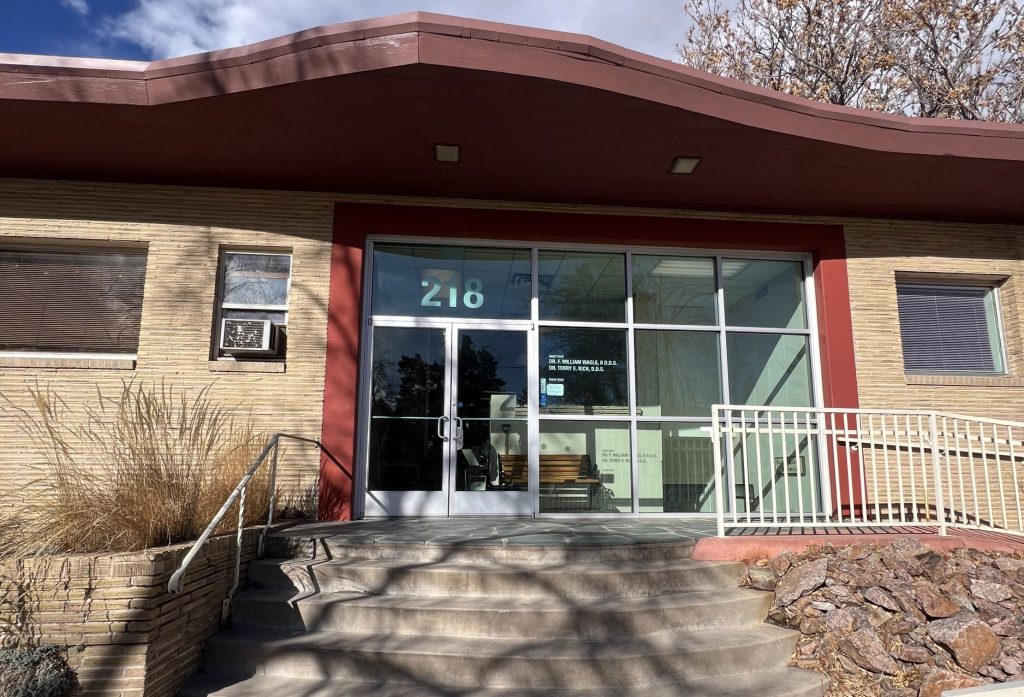Retainers

Retainers help maintain alignment after braces. Whether you’ve just completed your orthodontic treatment or are considering it in the future, understanding the role and different types of retainers is crucial for long-lasting results. Delve into the world of retainers and discuss their uses, benefits, drawbacks, and insurance coverage, with our team at The Downtown Dentist in downtown Colorado Springs, and make informed decisions about your oral health.
How do retainers work in dentistry?
Retainers in dentistry help maintain the position of your teeth after braces. They prevent teeth from shifting back to their original position, ensuring a straight smile. Retainers work by applying gentle pressure to the teeth, keeping them aligned.
Understanding Retainers in Dentistry
Orthodontic treatment corrects malocclusion, a condition where your teeth do not align properly. Upon completion of orthodontic treatment, your teeth are moved to new positions to achieve straighter, better-aligned smiles. However, teeth have a natural tendency to shift back to their original position, which is where retainers come into play.
Retainers are custom-made dental appliances that fit your teeth and help maintain the corrected alignment achieved through orthodontic treatment. By wearing retainers as directed, you can prevent your teeth from shifting back to their previous positions. Proper oral hygiene, including regular brushing, flossing, and cleaning your retainer, is vital to ensure their effectiveness.
The Role of Retainers After Orthodontic Treatment
After your braces are removed, you will receive retainers to wear as instructed. By consistently wearing your retainers, usually at night, you can reinforce the work already done by your braces and retain a straight, beautiful smile for years to come.
Regular retainer use is essential to keep your teeth in their corrected alignment. You may need to wear your retainers every night or follow a different schedule. Remember, every individual’s treatment plan is unique, so it’s essential to adhere to your specific retainer wear instructions provided by the experts at The Downtown Dentist.
Consistency is key when it comes to orthodontic retainers – the more diligently you follow instructions, the better your results. Neglecting to wear your retainers as directed can result in your teeth gradually shifting back toward their previous positions, undoing the hard work of your orthodontic treatment.
Different Types of Retainers and Their Uses
When it comes to retainers, there are different types available, each serving specific purposes based on individual needs.
- Permanent Retainer: This consists of a thin wire that is bonded to the back of your teeth, typically used for the lower teeth. Provides continuous support, as it remains in place 24/7, ensuring your teeth retain their corrected alignment. Offers long-term stability for your front teeth, which are more prone to shifting.
- Removable Retainer: Easily removed, making oral hygiene routines more manageable. Comes in different forms, such as Hawley retainers, clear plastic retainers, and Vivera retainers. Flexible, allowing you to wear them as instructed by your orthodontist.
- Hawley Retainer: Made of acrylic and wire, with the wire component sitting along the front of your teeth. Easy to adjust, allowing your orthodontist to make minor adjustments if necessary. Provides durable and reliable retention, making it one of the most popular retainer options.
- Clear Plastic Retainer: Made of a clear plastic material that fits snugly over your teeth. Offers discreet retention, making it an attractive option for those who prefer a less visible retainer. Careful cleaning prevents discoloration and retains its transparency.
- Vivera Retainer: Made by Invisalign, this type of retainer is designed for patients who have undergone Invisalign treatment. Offers a better fit and longevity compared to other removable retainer options.
- Choosing the right retainer type for your specific needs is essential to ensure the effectiveness of your orthodontic treatment. The Downtown Dentist will recommend the most suitable retainer option based on your case, considering your treatment goals, oral hygiene habits, and lifestyle.
Detailing the Permanent Retainers
Permanent retainers are affixed to your teeth for long-term retention. Unlike removable retainers, permanent retainers are durable, providing continuous support.
Permanent retainers, also known as lingual wires or bonded retainers, consist of a thin wire that is custom-fitted and bonded to the back of your lower front teeth. This retainer maintains the straight alignment of your lower teeth, which are more prone to shifting over time. Other devices that are available over the counter, called water flossers, make your flossing routine even simpler. A water flosser works much like a pressure washer. The wand has a thin tip that when aimed and released between two teeth shoots out a burst of high-pressure water, making it easier to clean around the lingual wire.
The Composition and Fitting of Permanent Retainers
The composition and fitting of permanent retainers are crucial to their effectiveness and overall comfort. Permanent retainers are made from durable materials, like stainless steel or a nickel-titanium alloy.
To fit a permanent retainer, an impression of your teeth will be taken, creating a mold that serves as a blueprint for the fabrication of your retainer. This ensures a precise fit that follows the contours of your teeth.
During the fitting process, the professionals at The Downtown Dentist will carefully bond the permanent retainer to the lingual (inner) surface of your teeth using dental cement. The wire is shaped and adjusted to align with the back surfaces of your teeth, providing stable retention without causing discomfort or irritation to your gums.
It’s important to remember that while permanent retainers are durable, they can break or become loose. Regular check-ups at The Downtown Dentist are essential to monitor the condition of your permanent retainer and address any concerns promptly.
Pros and Cons of Permanent Retainers
Permanent retainers offer several benefits, but it’s important to consider both the pros and cons when deciding if they are the right option for you.
Pros:
- Continuous Support: Permanent retainers provide ongoing retention, ensuring your teeth stay in their corrected alignment without the need for daily removal.
- Discreet: Since permanent retainers are bonded to the back of your teeth, they are not visible when you smile, offering a more discreet option compared to removable retainers.
- Long-Term Stability: With continuous retention, permanent retainers help maintain the alignment of your front teeth, which are more prone to shifting.
- Cons:
- Hygiene Challenges: Proper oral hygiene becomes crucial, as cleaning around a permanent retainer requires additional effort. Using a floss threader or other cleaning aids may be necessary.
- Risk of Breakage: Although durable, permanent retainers can break or become loose over time. Regular orthodontic check-ups help ensure any broken retainers are promptly repaired or replaced.
- Limited Movement: While permanent retainers are effective at maintaining alignment, they may offer limited movement of teeth compared to removable retainers.
Addressing Risks and Benefits of Retainers
Retainers play a significant role in maintaining the results of your orthodontic treatment, but it’s important to be aware of both the risks and benefits associated with wearing retainers.
One of the primary benefits of retainers is their ability to prevent your teeth from shifting back to their original positions. By consistently wearing your retainers, both removable and permanent, you can enjoy straight teeth and retain the results of your orthodontic treatment. However, for patients wanting to maintain their smile with minimal maintenance, a permanent retainer is the better option: it provides a quick and lasting solution that keeps the results of orthodontic care in place for as long as the retainer lasts, with minimal compliance.
However, it is important to note that fixed retainers can also pose risks, such as plaque accumulation and subsequent gingival inflammation if not properly cleaned. There are also specific oral hygiene considerations and risks that come with retainer wear.
How Long is a Retainer Typically Worn?
The duration of retainer wear varies from person to person, but typically it’s recommended to wear retainers full-time initially, transitioning to nighttime wear over time. For best results, long-term retention is recommended. This means that retainer wear may be required for a considerable period, even years, to maintain the correct positions of your teeth. This includes wearing a clear retainer regularly for the first six months following orthodontic treatment and then only wearing it while sleeping, making sure to invest a lot of time in wearing it as recommended. Lingual wires, on the other hand, are always worn as they are permanently in place.
How long you should wear your retainer depends on various factors, including the complexity of your orthodontic treatment, your oral habits, and the professional judgment of the experts at The Downtown Dentist. Remember, consistent retainer wear over time is essential for lasting results.
Proper retainer use reduces the risk of your teeth shifting back to their original positions, ensuring your smile remains straight and beautiful. While it may take time and dedication, maintaining your retainer wear is worth the effort to preserve your new smile.
Conclusion
Retainers play a crucial role in maintaining the results of orthodontic treatment. Understanding the different types of retainers and their benefits is essential for long-term oral health. Whether it’s a permanent retainer or a removable one, wearing them as prescribed ensures the alignment of your teeth remains intact. Preserve your beautiful smile for years to come with the help of our team at The Downtown Dentist in downtown Colorado Springs. Schedule an appointment by calling (719) 260-0216 for our Tejon Street location or (719) 633-3711 for our Willamette Avenue location.

 Dr. Rohleder
Dr. Rohleder Meet the Team
Meet the Team Sterilization Protocol
Sterilization Protocol Frequently Asked Questions
Frequently Asked Questions Careers
Careers












